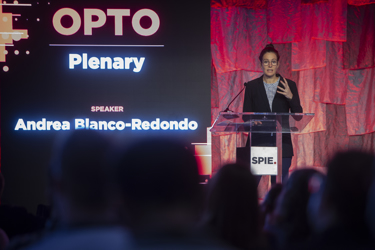Photonics West: Who, What, Where, When, And Why

SPIE Photonics West 2023, the world’s largest lasers, biomedical optics and biophotonic technologies, quantum, and optoelectronics event, is just around the corner. January 28 through February 2 in San Francisco, to be exact.
To help get you prepared for the show, we spoke with SPIE Senior Director of Technical Programs Marilyn Gorsuch – who is also the SPIE Photonics West event manager – about what attendees can expect, which hot topics are trending, and more.
And don’t forget to check out our coverage leading up to the show, as well as the videos we’ll be shooting on the show floor!
Photonics Online: What is new, improved, or just plain exciting at Photonics West this year?
Gorsuch: Well, we are very excited just to be back in person and welcoming more than 1,100 exhibitors to the Moscone Center exhibition floor — which includes the BiOS Expo — as well as hosting a technical program with over 4,000 presentations. In addition, paid registration for Photonics West includes access to the three-day SPIE AR|VR|MR conference and exhibition, so the week in San Francisco will offer a truly rich expanse of technical talks as well as a wide range of industry-focused offerings and, of course, many newly launched products in the exhibitions. This year also welcomes an increased focus on quantum with Quantum West becoming a bigger, more established part of the program. Our multiple plenary sessions — covering everything from biophotonics, to quantum, nano, and neuro technologies, as well as lasers and optoelectronic devices – always draw large crowds, as do the SPIE Startup Challenge and the SPIE Prism Awards. And I encourage you to check back with the program in the lead-up to the conference — it may very well include some exciting last-minute additions.
Photonics Online: What are the hot topics trending in advance of Photonics West?
Gorsuch: Photonics West encompasses four major application topics — BiOS, which highlights new research in biophotonics, biomedical optics, and imaging; LASE, with its focus on the laser industry and applications; OPTO, which covers optoelectronics, photonic materials, and optical devices; and the newest one, Quantum West, now in its second year, has a plenary session, as well as presentations from industry leaders who are focused on moving quantum technologies to market. We also have five dynamic application tracks to follow: AI/ML which showcases the use of artificial intelligence, machine learning, and deep learning to create intelligent systems across multiple sectors, technologies, and applications; Net Zero, addressing international goals for net zero energy consumption with optics and photonics; brain function and the latest related innovative technologies; translational research, with the latest photonics technologies, tools, and techniques impacting healthcare; and 3D printing, with its focus on innovative ways to apply this multidimensional technology. But equally important are the many opportunities to network and come together as a community. We’re very much looking forward to hosting SPIE Photonics West live and in person.
Photonics Online: How many presentations will there be and are you particularly excited about any?
Gorsuch: There are more than 4,000 presentations on the schedule this year, and I’m very excited to welcome our community to all of them. Presenting your work at a conference is an important step in the process of advancing scientific research or engineering progress, and a critical part of building a career. Presenting at our field’s largest event should be celebrated, and I am thankful for all of the hard work our presenters — and our volunteer conference chairs — have put into helping make Photonics West a must-attend event.
Photonics Online: What about special events? There are more than 100 of those on the schedule. Which ones are the “can’t miss” ones — and why?
Gorsuch: We have a very full week planned for San Francisco, and I think every event will be really valuable to someone. I encourage our attendees to find events that match their area of focus or pique their interest, and to go to as many networking and social events as possible — these are a wonderful, relaxed way to engage with the community. In-person events are really about making connections, and SPIE Photonics West has more face-to-face opportunities than any other event on the optics and photonics calendar.
Photonics Online: The SPIE community is highly engaged. What are you offering attendees in terms of professional development, family care, advocacy, equity, diversity, and inclusion opportunities?
Gorsuch: We have a wonderful new gathering place this year — the Moscone West Community Park, a communal area where you can attend specific networking and professional development events, or just use the space to relax, chat, and recharge between sessions. More than 20 professional development opportunities will be held during the week; you can learn how diversity drives and impacts collaborative success through a series of EDI-focused, industry-sponsored “Lunch and Learns”; and, as usual, we are offering our SPIE Family Care Grants which supplement caregiving costs for SPIE Members.
About SPIE
SPIE, the international society for optics and photonics, brings engineers, scientists, students, and business professionals together to advance light-based science and technology. The Society, founded in 1955, connects and engages with our global constituency through industry-leading conferences and exhibitions; publications of conference proceedings, books, and journals in the SPIE Digital Library; and career-building opportunities. Over the past five years, SPIE has contributed more than $22 million to the international optics community through our advocacy and support, including scholarships, educational resources, travel grants, endowed gifts, and public-policy development. www.spie.org.
